#kerala dish
Explore tagged Tumblr posts
Text

My father just sent this to me, completely unprompted, and I have no clue why. But also he's right though
#'quite so old fruit. where's the rush what?' has got to be one of the phrases of all time. anyways#south asian father in household that will not pay for cable/dish television simulator: cricinfo is just open 24/7#when i was a kid my dad would try to not use screens on saturdays#because he had a programming job and wanted to like detox i guess??? idk#but sometimes there would be a big cricket match and he'd try to cheat the system by asking me to look at the scores lol#honestly the most cricket i watched was in middle school when me and my best friend's brother would watch it#but that was just t20s test cricket still does not click for me#just hit some fours and sixes already#i do think its funny conceptually though. big fan of game that takes five days to play and they break for meals#would blame the fact that i like football on the fact that my family's from kerala but as you can see they are all cricket people so ://#there goes that excuse#perce rambles
3 notes
·
View notes
Text
Fridge Cleanup Veg Recipes - Pav Bhaji Masala and Aviyal
#aviyal#coconut-based curry#Comfort food#easy dinner ideas#flavorful dishes#fridge cleanup recipes#healthy Indian meals#healthy recipes#homemade pav bhaji#Indian street food#Kerala recipes#meal ideas with leftovers#minimal food waste#Pav bhaji masala#quick Indian recipes#south indian cuisine#vegetable recipes#vegetarian recipes#versatile recipes#Wholesome Meals#yogurt gravy
0 notes
Text
The Best Dishes In Kerala Cuisine
Kerala, a beautiful state located on the southwestern coast of India, is known for its rich and diverse culinary heritage. The unique blend of spices, flavors, and techniques used in Kerala cuisine has made it a favorite among food lovers worldwide. In this blog, we will explore the best dishes in Kerala cuisine that you can enjoy on your next place to visit in kerala in this culinary paradise.

Appam with Stuffing:
Appam is a traditional Kerala breakfast dish made from fermented rice and coconut milk batter. It is a steamed, soft, and fluffy pancake, which is usually served with a variety of stuffings such as egg, onions, and meat.

Fish Curry with Rice:
Fish is an essential part of Kerala cuisine, and the state is blessed with abundant freshwater and marine life. The fish curry, prepared with a blend of spices and coconut milk, is often served with steamed rice for a complete meal.

Kerala Biryani:
Kerala Biryani is a popular rice dish that originated in the state. It is a mouth-watering combination of spices, vegetables, and meat, cooked in a dum-style with layers of rice, and garnished with fresh coriander and mint.

Unniappa:
Unniappa is a dessert made from freshly grated coconut, jaggery (palm sugar), and milk. It is a traditional Kerala sweet that is perfect for satisfying your sweet tooth.

Conclusion:
Kerala cuisine is a treasure trove of flavors and culinary delights that offer a unique gastronomic experience. From traditional breakfast dishes to sweet desserts, Kerala’s rich and diverse food culture is a must-try for any food lover. So, the next time you plan a trip to Kerala, make sure to indulge in these mouth-watering dishes and savor the flavors of this culinary paradise.
0 notes
Text
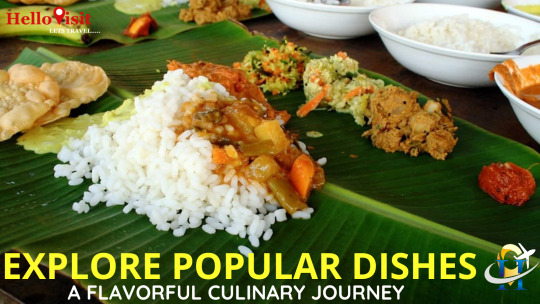
List of Best Popular Dishes in Kerala for your Next Trip
Unlock the flavors of Kerala as you travel through this gastronomic wonderland! From the aromatic spices of Meen Curry to the comforting fluffiness of Appams, each dish is a vibrant story on your plate. Join the culinary adventure, savoring iconic dishes like Puttu-Kadala, and experiencing the cultural tapestry of Kerala's cuisine.
0 notes
Text
Enjoy Our Delicious and Event Indian Menu
You might be wondering how you will cater to the different preferences in food all your guests most likely have. Well, Brightkitchen takes care of this with a menu designed to satisfy everyone’s taste buds.

phone no: 9952117009
email: [email protected]
#Catering service#Catering service in Viluppuram#Flavors#Starters#Dessert#Coastal dishes#Seafood#North Indian cuisine#Italian cuisine#Continental cuisine#Chinese cuisine#Chettinad cuisine#Kerala cuisine#Traditional menus
0 notes
Photo

Tampa Coconut Cilantro Rice The subtle sweetness of this basmati rice, cooked in coconut water and finished with cilantro and butter, goes well with spicy curries.
0 notes
Text
Fish Dishes in India: A Journey Through the Flavors of the Sea
India is a land of diverse cultures and cuisines, and seafood is an integral part of many regional cuisines. With a long coastline and many rivers, India has an abundance of fish and seafood that is used to create a variety of delicious dishes. From the tandoori fish of Punjab to the fish curry of Kerala, the flavors of the sea can be found in every corner of the country. In this article, we’ll…
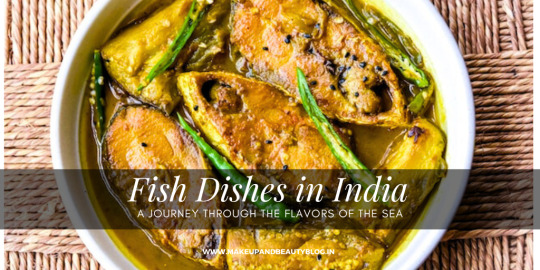
View On WordPress
#BlogchatterA2Z#Fish biryani#Fish dishes#Fish Koliwada#Fish Molee#Fish tikka#Goan fish curry#indian cuisine#Indian seafood#Kerala fish curry#Regional cuisine#Seafood
1 note
·
View note
Text
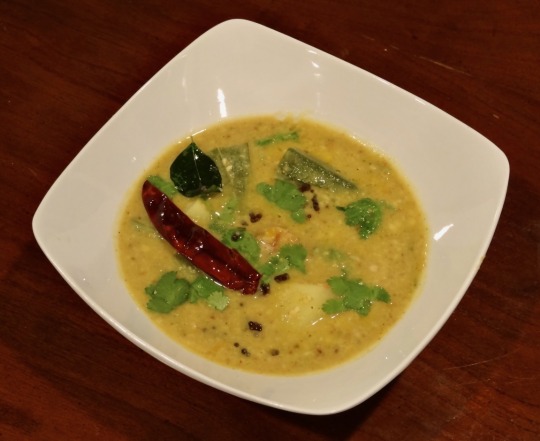
[ID: A bowl of a bright yellow stew topped with cilantro, mustard seed, chili, and curry leaf. End ID]
ಉಡುಪಿ ಸಾಂಬಾರ್ / Udupi sambar
A sambar is a lentil-and-vegetable stew distinguished by the use of a particular spice blend (Hindi: सांबर मसाला "sāmbār masālā," "sambar spice"; Kannada: ಸಾಂಬಾರ್ ಪುಡಿ "sāmbār puḍi," "sambar powder"). Sambars are a staple of South Indian and Sri Lankan cooking, sometimes made in households for multiple meals a week. The word "sambar" can be traced back to the Sanskrit सम्भार "sambhārá," "collection of things required for a particular purpose”; “spices."
The lentil used in sambar dishes is usually tur dal (split pigeon peas), though arhar dal, tuvur dal, or even blends containing masur or mung dal may be used, depending on the cook or the region. Vegetables also vary between combinations of okra, potato, ash gourd (petha), bottle gourd (doodhi / lauki), drumstick (saijan ki phalli), beetroot, tomato, carrot, pumpkin, brinjal, and pearl onions, among others. The sambar masala fries chilis, curry leaves, dal, and various spices including cumin, coriander, and fenugreek, then grinds them into a spicy, earthy, fragrant blend.
This recipe makes a sambar in the style of ಉಡುಪಿ (Udupi) cuisine—a subdivision of the cuisine of the ತುಳುವ (Tuluva) people localised in the Udupi District of Karnataka, a southeastern coastal state of India. (Tuluva cuisine is also commonly found in Dakshina Kannada, Karnataka, and Kasaragod, Kerala). In the Udupi region, sambar may be known as "ಕೊಡೆಲ್" "kodhel"; perhaps related to "ಕಡಲೆ" "kadhale" "Bengal gram"; or "ಹುಲಿ" "huḷi"; "tartness." Udupi huli has coconut oil and jaggery as its primary distinguishing features: the jaggery's deep sweetness and the earthy pungency of unrefined coconut oil combine with the spice of the chilis and the sour fruitiness of the tamarind to create a complex, flavorful, well-balanced dish.
Udupi huli may be further divided into a few major types. ಮಸಾಲೆ ಹುಳಿ ("masāla huḷi") contains shredded coconut and vegetables; ಬೋಳು ಹುಳಿ ("bolu huḷi") contains vegetables, but omits the coconut.
Hotel-style masala huli recipes typically add a lot of jaggery to produce a distinct sweetness; cut back on the amount of coconut included; and contain onion and garlic. The other main type of masala huli—“temple style”—is sattvic (from Sanskrit "सत्त्व" "sattva": "goodness," "essence," "existence"), which in this context means that onions and garlic are excluded.
A sattvic diet in Hinduism centres around the concept of maintaining sattva by eating only pure and mild (sattvic) foods, and omitting tamasic (“dark,” "inert," "destructive"; from Sanskrit तमस् "tamas") and rajasic ("exciting," "passionate," from Sanskrit रजस् "rajas") ones. The concepts of sattva, tamas, and rajas (the गुण "guṇa" system) are central to the construction of caste: the degree to which each person innately inherits each quality supposedly determines their possession of characteristics including honesty, intelligence, and goodness (sattva), stupidity and lack of creativity (tamas), and passion and pridefulness (rajas); the possession of these characteristics in turn determines their rightful place in a professional and social hierarchy. The association of certain foods with certain qualities thus links diet to caste: a distinction in diet is one of the methods by which those belonging to upper castes maintain and police caste boundaries.
This recipe makes enough pudi for one pot of sambar. Traditionally, sambar pudi is created fresh each time the dish is made, but many households make large batches and store them. In this case, omit the coconut; or, use dried coconut and store the masala in the refrigerator.
Recipe under the cut!
Patreon | Paypal | Venmo
Ingredients:
Serves 4-6.
For the sambar:
2 cups chopped vegetables
1 red onion, sliced*
1 cup (200g) yellow split pigeon peas / tur dal / ತೂರ್ ದಾಲ್ (ಹಳದಿ ಸ್ಪ್ಲಿಟ್ ಪಾರಿವಾಳದ ಬಟಾಣಿ)
4 cups (1 litre) water, or as needed
1/4 tsp ground turmeric / haldi / ಅರಿಶಿನ
2 tsp table salt
2 tsp jaggery / gur / ಬೆಲ್ಲ*
1/4 cup (60mL) tamarind pulp (from 1 Tbsp dried tamarind / imlie / ಹುಣಸೆಹಣ್ಣು)
2 tsp unrefined coconut oil / nariyal ka tel / ತೆಂಗಿನ ಎಣ್ಣೆ
Ingredient list format is English / Hindi (Latin transcription) / Kannada. The Hindi is provided for convenience while shopping.
Udupi sambar usually uses any of: gourd, brinjal (Indian eggplant), pumpkin, dumstick (saijan ki phalli), and okra. Pearl onion is not usually used in this region, but you can add whatever you want, according to taste.
*For a hotel-style sambar, include the onion; increase the jaggery to 2 Tbsp.
For the spice paste / sambar masala / ಸಾಂಬಾರ್ ಪುಡಿ ("sambar pudi"):
1/2 Tbsp split Bengal gram / chana dal / ಹಳದಿ ಸ್ಪ್ಲಿಟ್ ಗ್ರಾಂ
2 tsp split black gram / urad dal chilka / ಸ್ಪ್ಲಿಟ್ ಬ್ಲ್ಯಾಕ್ ಗ್ರಾಂ
2 tsp coriander seeds / dhaniya / ಕೊತ್ತಂಬರಿ ಬೀಜದ
1/2 tsp fenugreek seeds / methi / ಮೆಂತ್ಯ
1 tsp cumin seeds / jeera / ಜೀರಿಗೆ
1 tsp ground turmeric
5-6 curry leaves / kari pati / ಕರಿಬೇವು
3-4 Byadagi or other dried red chilis / byadagi mirch / ಬ್ಯಾಡಗಿ ಮೆಣಸಿನಕಾಯಿ
4 cloves garlic, skins on*
Large pinch asafoetida / hing / ಇಂಗು
1 cup (100g) fresh coconut (about one coconut)*
1/2 cup (120mL) water
While the ratio of ingredients in Udupi sambar pudi vary slightly, the ingredients themselves are almost always consistent.
*For a hotel-style sambar, include the garlic, and decrease the coconut in the sambar masala to 1/4 or 1/2 cup (25-50g).
The grams and pulses in this pudi have many different names. You can find them in a halal or South Asian grocery store; look on the bag for the Hindi names (since they have been transcribed into Latin, the spelling may vary from what you see here).
The urad dal you find may be husked, and thus yellow instead of black; these will work just as well.
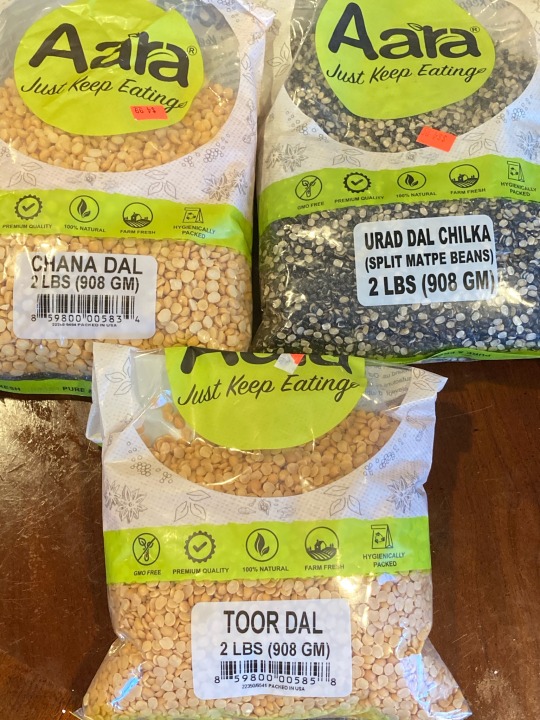
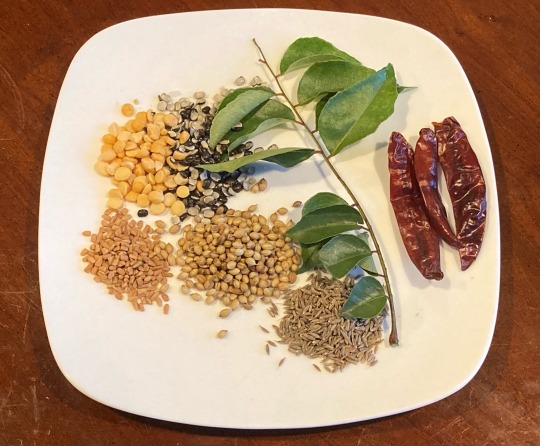
For the tempering / tadka / ಹದಗೊಳಿಸುವ:
2 Tbsp unrefined coconut oil
2 red chilis
8 curry leaves
1 tsp brown mustard seeds / rai / ಸಾಸಿವೆ ಬೀಜಗಳು
Recipes from north Karnataka may add cumin and whole, unpeeled garlic cloves to the tempering.
Instructions:
For the sambar pudi:
1. Break open the coconut and remove and shread its flesh.
If using a whole dried coconut, break into the shell with the wrong side of a hammer and pry open. Break into a few smaller pieces and peel with a vegetable peeler until the skin is removed from the white flesh, wearing something to protect your hand. Soak in warm water for several minutes to soften, and then grate or food process.

2. Heat 2 Tbsp of coconut oil in a skillet on medium-low. Add asafoetida and fry for 30 seconds, until no longer raw-smelling. Add dal and fry, stirring often, for 30 seconds until golden brown; add coriander, mustard, fenugreek, and cumin seeds and fry until fragrant.
3. Add curry leaves and fry until wilted, then add garlic and dried chilis and fry another 30 seconds to a minute, until fragrant.
4. Add coconut and fry, stirring often, for another few minutes until a shade darker. Add turmeric and stir.
5. Grind all ingredients into a paste in a mortar and pestle, then mix in about 1/2 cup water to loosen (if using dried coconut, you may need more water).
Or, put all ingredients along with 1/2 cup water into a blender or food processor and process until a relatively smooth paste forms.
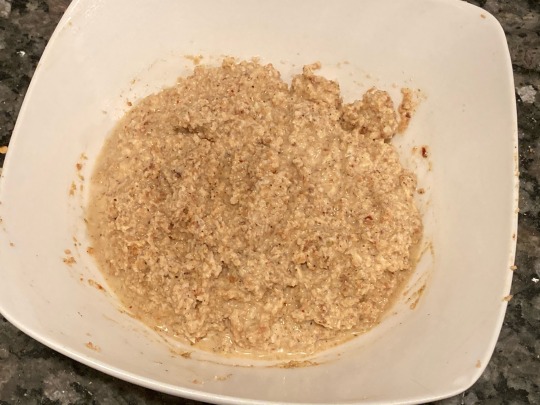
For the sambar:
1. Wash tur dal to remove excess starch. Simmer dal with 2 cups water, 1/4 tsp ground turmeric, and 1 tsp coconut oil for about 30 minutes until very tender. Mash until relatively smooth with a wooden spoon or bean masher, or process briefly with an immersion blender.
You may soak the dal in water after rinsing them to reduce the cooking time, but it is not necessary.
2. Meanwhile, make the tamarind paste. Soak 1 Tbsp tamarind dried pulp in 1/4 cup hot water for 20-30 minutes. Squeeze the tamarind into the water to extract the pulp. Discard the tamarind seeds and husk. Optionally, depending on your preferred texture, push the mixture through a metal sieve.
3. Prepare vegetables. Slice the onion; remove ends of okra and drumsticks and cut into 2-inch pieces; quarter tomatoes; quarter brinjal; peel pumpkin and cut into cubes; peel and cube potatoes.
4. If using onion, add a teaspoon of coconut oil to a large pot and fry until translucent.
5. In the same pot, boil vegetables in just enough water to cover, along with a pinch of salt, until they are beginning to soften.
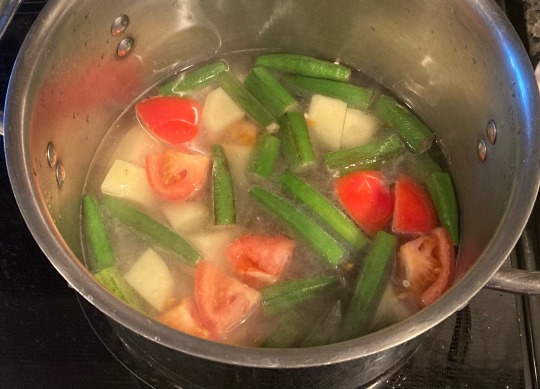
Some recipes call for the vegetables to be boiled, and others call for them to be steamed. I prefer boiling, since it produces a nice savory broth.
6. Mix vegetables, dal, tamarind, jaggery, sambar pudi, and salt to taste and simmer 5-10 minutes to allow flavors to combine and vegetables to cook under tender. Add water as needed. Remove from heat and stir in cilantro. Taste and adjust salt.
The final sambar should be pourable, like a thick soup—Karnataka sambar is typically thinner in consistency than Tamil Nadu versions.
For the tadka:
1. Heat coconut oil in a small skillet on medium heat. Add tempering ingredients and fry, stirring often, until chilis and curry leaves are a couple shades darker and the mixture is fragrant.
2. Pour the oil and tempering ingredients into the sambar and stir in. If you like, retain some of the tadka as a garnish to serve.
3. Serve warm, in individual bowls, alongside long-grain white rice. To eat drumsticks, scoop the center out and eat it; the tough outer rind is left.
If you intend to save some sambar, it's a good idea to make just enough tadka for what you plan to eat that day, and then make fresh tadka to pour over the reheated leftovers.
112 notes
·
View notes
Text
🌴🔥 Dive into the heart of Kerala's culinary traditions with this special dish prepared in a rustic village kitchen. Experience the rich flavors and homely warmth of Kerala cuisine, straight from the heart of the village. 🍲🌶️
#cooking#recipe#food#vegetarian#food recipes#chef#easy#foodie#foodporn#food photography#food and drink#chicken#onion#garlic#indian food#asian food#traditional food#village food#spicy food#tasty food#fyp#for you#trending video#cooking videos
9 notes
·
View notes
Text
In Israel, you’ll find a patchwork of different communities. Most Israeli Jews originate from Europe, North Africa and the Middle East, but some come from other regions, such as India.
According to the Indian Embassy in Tel Aviv, there are about 85,000 Jews of Indian origin in Israel — so Indian Jews make up just 1.2% of Israel’s Jewish population. This small community is divided into four groups: the Bene Israel from Maharashtra, the Cochin Jews from Kerala, the Baghdadi Jews from Kolkata, and the Bnei Menache from Mizoram and Manipur.
Although I grew up in the U.S., my mother’s family is from the Cochin Jewish community in Israel. I wanted to find out more about how this community is preserving our unique Jewish traditions from the South of India.
Many of these traditions are at a risk of dying out. For example, the language of the Cochin Jewish community is called Judeo-Malayalam. Today, this dialect has only a few dozen native speakers left (you can hear it spoken in this video).
According to legend, the first Jews arrived in Cochin during the time of King Solomon. The oldest physical evidence of their presence is a set of engraved copper plates dating from around 379-1000 CE, which were given to community leader Joseph Rabban by the Chera Perumal dynasty ruler of Kerala.
Jewish sailors originally arrived in Kodungallur (Cranganore), an ancient port city known as Shingly by Jews, before shifting to Cochin following a flood in 1341. These Jews became known as the Malabari Jewish community. After the expulsion of Jews from Spain in 1492, a group of Sephardic Jews also came to Cochin, and became known as the Paradesi (Foreign) Jews. The Malabari and Paradesi Jews historically lived separately and maintained their own traditions, although in modern times this division has become less important.
Today, the vast majority of Cochin Jews live in Israel. I spoke with several community members to learn about current projects in Israel to preserve Cochini Jewish culture.
Hadar Nehemya, a jazz musician and performer, runs a food delivery service sharing traditional Cochin Jewish recipes. Hadar learned the art of cooking from her mother, who learned it from her paternal grandmother.
Cooking her dishes from scratch and selling them at markets and for delivery, Hadar’s goal is to introduce Cochini cooking into the mainstream of Israeli culture. “Many Israelis don’t know much about Cochin Jewish culture. Maybe they met a Cochini person in the army,” she said. “But Indian food is popular in Israel, because Israelis love to visit India after they finish their army service.”
Cochin Jewish cuisine is similar to other types of South Indian cuisine, but also has influences from Iberian and Middle Eastern cooking. One example is pastel, pastries with a spicy filling that are similar to empanadas. Other staples include fish and egg curries, chicken stew, black-eyed pea stew, dosa (thin rice pancakes) and dishes cooked with coconut and mango.
Hadar’s favorite dishes to cook are idli and sambar, which are often eaten together. Idli is a type of savory rice cake, while sambar is a spiced lentil stew. Although Hadar says it’s difficult to maintain an Indian food business from an economic perspective, she’s passionate about cooking and enjoys creating homemade dishes with the right balance of spices.
Along with cooking, music is also important in Cochini culture. In most religious Jewish communities, women aren’t permitted to sing in front of men who aren’t their immediate relatives. However, this prohibition was not part of the Cochini tradition.
In the Cochin Jewish community, women have sung in Hebrew and Judeo-Malayalam for centuries. Piyyutim (liturgical poems) were sung in the synagogue or at people’s homes during holidays. Judeo-Malayalam folk songs were sung at weddings and special occasions, and the lyrics of these songs were recorded in notebooks to hand down to future generations. Later, many women also learned Zionist songs in preparation for moving to Israel. I have memories of my own grandmother singing these songs at home.
In recent years, audio recordings have been produced of Cochini songs, including a collection called “Mizmorim” (Psalms) featuring Hadar’s grandmother, Yekara Nehemya. Hadar then created her own version of one of the songs, “Yonati Ziv.”
Today, community leader Tova Aharon-Kastiel has organized a choir which meets once or twice a month at different locations. In the choir, Cochini and non-Cochini women, mostly aged 65-85, sing songs in Hebrew and Judeo-Malayalam. The older generation is eager for the younger generation to get involved, but since most younger Cochin Jews have a mixed background and are assimilated into mainstream Israeli culture, this is sometimes proving a challenge.
Still, many young Cochin Jews are eager to connect with their roots. The community maintains several Facebook groups, including one specifically geared towards the younger generation. The group description reads: “If you are a young Cochini, you surely know (at least partially) the wonderful heritage of our forefathers and mothers… the sad truth is that this heritage is currently on its way to pass from the world.”
Shlomo Gadot is the CEO of Inuitive, a semiconductor company, and is actively involved with Cochini community projects. His nephew, Ori, runs the Facebook group for the younger generation. Shlomo says events are regularly held at the Indian Embassy in Tel Aviv for young Cochinis. “Normally the embassy gives them their office in Tel Aviv, and they invite the young Cochini people to come there and do a trivia contest,” he said. “They do it twice a year, once at Hanukkah and once at Passover.”
According to Shlomo, the embassy also has initiatives to create connections between Indian and Israeli tech companies. “Sometimes they invite people to the ambassador’s house or office to see how they can create connections between Israeli and Indian companies,” he said. “They also have a program to bring young people to India to help them get to know India better.”
Anil Abraham is one of the few Cochin Jews with recent memories of life in India. Born in Jerusalem, his family returned to India when he was 8 years old, and he lived there until age 35 before migrating back to Israel. He says he found growing up Jewish in India difficult, but rewarding. “It was very difficult to move there from Israel and learn Malayalam,” he said. “But it was amazing to be part of the community and enjoy Cochini food prepared from scratch. We used to attend prayers in the Paradesi Synagogue, because right now there are fewer than 20 Jews in Kerala.”
Today, Anil runs tours of Kerala for the Cochin Jewish community and others. “The kids travel with their parents and grandparents to India,” he said. “That’s how our traditions are passed down.”
16 notes
·
View notes
Text
This Melodious Rain(it's all you)
This is a re-release because my chapter has finally been edited by the darlingest of betas @the-life-support-system
shoutout to jamie everyone
***
Chapter 1
Meera's POV
You might ask me how the fuck did it come to be like this.
I'm sitting in one of the many pews of the most beautiful church I have ever seen. The girl I love is getting married to some guy at the altar, who waltzed into our lives without permission.
Lisa looks like she is about to cry. I wish to comfort her, but she has already denied my companionship. Why in the ever-loving hell would she want my comfort?
She has chosen her path, and I can't do anything about it.
Why does it feel so stuffy in here? There are air conditioners but it feels like I'm about to puke.
I look at them and I hate them. I hate her. I hate the guy, I hate this love that had to blossom in my heart for the most unavailable person and I hate myself for beginning to want to be the person taking her veil off even after everything.
Yet, I'm not able to take my eyes off her. It's like every movement of hers pulls me like a magnet. I love her and she loves me too, because I can see her watching me from the corner of her eyes. But she has made her choice.
That is us. We are better off when we don't have to face anything.
*********
The evening of her graduation and the morning after it would always be a memorable period for Meera. Not because she graduated from some godforsaken engineering college, or because she had finally got an assistant director's job under Suresh Prabhakar (though that was one of the top contenders), but something else.
She had gone to Suresh Prabhakar's set, had been introduced by Krishna, the guy with the connections who was her senior from her college and had rigorously tried to learn everything that was to be learnt.
She had come back home a few hours ago. She was lying on her bed, the little script book clutched to her chest. It was the best feeling. She’d been lying like that ever since she came back home at 9 o’clock. She couldn’t sleep at all. She checked the time using her phone. It was 4:20 a.m.
The room was too stuffy, too small for the big things she felt at that moment. She had to step out. She sat down on the wicker chair in their balcony, looking down at the quiet street of their neighbourhood. They lived on a residential street, and one could seldom see vehicles passing through this place. Sometimes you could hear the ghost of a honking car if you were lucky.
She was swept away by her dreams of making big in film, when she heard the gate open. It was 4:30 in the morning. Why would anyone be entering the house at such an ungodly hour?
She peered closer over the edge of the railing. It was...a woman.
Ah. Not a robber. It was the daughter of their tenants, the Palackals. Her father had mentioned something along the lines of someone from downstairs working a midnight shift. She had thought it was the uncle, not the daughter.
3 months ago, a Kerala family had come to rent their ground floor house. A contact of her father who was also a contact of the uncle showed the family to the house. Talks had gone down and finally the downstairs house had been rented. Most of the time, the families avoided contact with each other due to the language and culture barrier experienced throughout the first month (the interaction being just the parents), but Meera knew a few details here and there. They were a family of four - the parents and a sister and a brother - Christians and very, very fond of meat. The last one was ascertained by the fact that every time the aunty cooked, the smells wafted upwards and they had to shut their windows and doors when they cooked a particularly smelly dish. They would give a little bit of their curries every time they cooked though (not the beef, of course). Meera and Veena liked them enough, her parents did not touch them. The aunty was nice about it, so perhaps that was what made the peculiar dishes tasty. Athididevobhava: after all.
She had never seen the siblings' faces though. She wanted to say hello, but she wondered if the other woman would be startled by a rando saying hello to her in the midst of the night. In spite of that, her curiosity did not dampen even a little bit. Why would it? A normal landlord wouldn't go 3 months without knowing the face of their tenants.
Perhaps god had heard her wish, because as she peered from the railing, the woman looked up.
Oh, boy.
Her curly black hair fluttered in the light breeze that seemed to pass by just at that moment. Her dark skin shone with little beads of perspiration above her upper lip. Her beautiful, dark brown eyes twinkled in the little bit of sunlight that came through. She clutched her Bisleri water bottle as she looked up.
Their eyes met. Shrouded in the morning mist, the woman raised a subtle eyebrow.
At four-thirty in the morning on a random Tuesday, Meera had come face to face with the goddess Usha.
Meera tried to adjust the way she looked, knowing it was all in vain. She had got out straight from bed and looked as sweaty and weird as she felt.
The goddess looked radiant. She didn't know how it was possible to look flawless on a night-shift, but this woman achieved it.
Meera felt like she had to take a picture of this.
And so she did.
"What the fuck" came out of two mouths (one of them her own) in two very different tones.
#this melodious rain (it's all you)#this really feels like something i want to commit to ngl#little bubbles are popping in my head with ideas in them#like yk those fleeting images and stuff? yeah those ideas#anyways i hope everyone has fun reading this#!!!
30 notes
·
View notes
Text
Unparalleled Facilities: Everything You Need for the Perfect Getaway

Munnar: A Glimpse of Paradise
Munnar, located in the scenic Western Ghats of Kerala, is a tranquil hill station known for its lush tea gardens, dense forests, and cool climate. Nestled at an altitude of 1,600 meters, this picturesque town offers breathtaking views, making it an ideal getaway for nature enthusiasts, adventure seekers, and anyone looking for a peaceful retreat. Surrounded by misty mountains, Munnar is one of the best places to stay in Kerala, offering travelers the perfect blend of serenity, adventure, and luxury.
Accommodation at the Top Luxury Resort in Munnar
At one of the top luxury resorts in Munnar, you’ll experience comfort like never before. The resort offers a variety of rooms, including Royal Suites, Premium Suites, Super Deluxe Rooms, and Deluxe Rooms, each designed to provide the utmost comfort and privacy. Whether you're on a family vacation, a romantic getaway, or simply seeking a peaceful retreat, the accommodation options are perfect for all types of travelers.
The Royal Suites are spacious and elegantly furnished, offering an exceptional level of luxury, while the Premium Suites provide added space and comfort for a more lavish experience. For those who prefer a more budget-friendly option, the Super Deluxe Rooms and Deluxe Rooms offer comfort and convenience with stunning views of the mountains and tea plantations. Each room is equipped with modern amenities like high-speed Wi-Fi, room heaters, and 24x7 room service, ensuring that your stay is nothing short of perfect.
Dining: A Culinary Experience Amidst Nature
Dining at this resort is an experience in itself. The resort’s multi-cuisine restaurant, which comprises an open-air area with panoramic mountain views and a comfortable indoor setting, offers a delightful culinary journey. Situated conveniently between the lobby and the complement of rooms, this restaurant is elegantly furnished with a profusion of wood, creating a warm and inviting atmosphere.
The menu at the restaurant includes authentic Kerala cuisine, as well as culinary delights from other regions of India and internationally curated dishes. From spicy Kerala seafood curries to Indian vegetarian specials, and from global favorites to freshly prepared local delicacies, every meal is a treat. Guests can enjoy their meals while soaking in the majestic views of the surrounding mountains and valleys, making it one of the best dining experiences in Munnar.
Facilities: Everything You Need for a Relaxing Stay
When it comes to facilities, this resort spares no expense. Guests can enjoy:
Restaurant: The open-air dining area overlooks the mountains, providing a serene environment for meals (32-person seating capacity).
24x7 Reception: Always available to assist with your needs.
High-speed Wi-Fi: Stay connected while you unwind in the lap of nature.
Gym: Keep fit during your stay with modern fitness equipment.
Recreation Centre: A space for entertainment and relaxation.
24x7 Hot Water: For your convenience, enjoy hot water any time of the day.
Amphitheatre: A charming space for performances and gatherings.
SPA: Rejuvenate your mind and body at the resort's best spa, offering a range of treatments.
Warm Infinity Pool: A breathtaking infinity pool for both adults and kids to enjoy.
Flower Garden: Wander through beautiful flower gardens, perfect for a relaxing stroll.
Manmade Cave & Waterfall: Explore the enchanting manmade cave and waterfall for a touch of adventure.
Activities: Adventure and Fun Await You
The resort offers a wide range of activities for guests to enjoy. Whether you're looking for adventure or relaxation, you can indulge in:
Cycling: Explore the scenic beauty of Munnar on a bicycle.
Scooter Ride: Zoom through the misty roads of Munnar.
Campfire with Barbecue: Enjoy an evening under the stars with a traditional campfire and barbecue.
Trekking: Discover the hidden gems of Munnar on an exciting trek.
Evening Walk: Take a relaxing walk around the resort in the cool evening air.
Cooking Demo: Learn to prepare Kerala delicacies with expert chefs.
Towel Art: Watch and learn the art of towel folding.
Jeep Safari: Take an exciting jeep safari through the tea estates.
Amphitheatre: Attend evening shows and performances in the amphitheatre.
Places to Visit Around Munnar
Munnar is surrounded by natural wonders and fascinating landmarks. Some must-visit places nearby include:
Top Station: Offering panoramic views of the Western Ghats and the valleys below.
Pampadum Shola National Park: A haven for wildlife enthusiasts and nature lovers.
Escape Road: A scenic drive through misty forests and tea gardens.
Kolukkmalai: The highest tea estate in Kerala, offering stunning views.
Marayur: Known for its ancient rock paintings and sandalwood forests.
Munnar Stay: A Wellness Retreat for Your Mind and Body
If you’re looking for a wellness retreat, this resort offers an excellent option for rejuvenation. The resort is also renowned for being one of the best wellness resorts and Ayurveda resorts in Munnar. It provides guests with a serene and peaceful environment, perfect for those seeking relaxation, meditation, and holistic healing.
The spa is one of the best in the region, offering a wide range of therapeutic treatments, including traditional Kerala massages, Ayurveda therapies, and rejuvenating wellness packages. Guests can also enjoy the infinity pool, soak up the fresh mountain air, and unwind in an atmosphere designed for relaxation and renewal.
Conclusion: Why Choose This Resort in Munnar?
Whether you're planning a luxurious family holiday, a romantic getaway, or a wellness retreat, this luxury resort in Munnar offers everything you need for an unforgettable stay. From spacious suites and deluxe rooms to world-class facilities and stunning views, it is truly one of the best resorts in Munnar. You’ll find peace, adventure, and relaxation all in one place, making it one of the top 5-star resorts in Munnar Kerala.
For those seeking a Munnar stay with a pool, this resort offers the perfect combination of luxury and nature, with its infinity pool and wellness center. It’s an experience you’ll cherish forever, whether you're visiting for a romantic trip, a family vacation, or a wellness retreat. If you’re looking for the best resorts in India, this is the place to be!
2 notes
·
View notes
Text
Recognize Indian food dishes effortlessly! From the aromatic flavors of Kerala to the spicy delights of Tamil Nadu, identify and explore a wide range of Indian cuisines in bulk.
2 notes
·
View notes
Text
Tourist Places in Kerala for 2 Days
Kerala, often dubbed "God's Own Country," is a treasure trove of lush landscapes and vibrant culture. Did you know that even with just two days, you can experience some of its most stunning tourist spots? It’s true! Imagine sipping tea in the misty hills of Munnar one day and gliding through the tranquil backwaters of Alleppey the next. This enchanting state offers an astonishing variety of experiences packed into a short itinerary. So, buckle up for an unforgettable journey as we explore how to make the most out of your quick getaway to Kerala!
<<<<<<<<<Tourist Places in Kerala for 2 Days>>>>>>>>>

Day 1: Munnar
Munnar is like stepping into a dream! Imagine lush green tea plantations stretching endlessly, kissed by mist and sun. The air smells of fresh leaves and the earthy aroma of spices. You can explore stunning viewpoints that leave you breathless. Don’t miss the chance to visit the famous Tea Museum where history meets flavor. You might even spot local wildlife while trekking through picturesque trails! It's an enchanting experience that will stay with you long after your visit.
Day 2: Alleppey
Alleppey, also known as the "Venice of the East," is nothing short of breathtaking. Imagine gliding through serene backwaters on a traditional houseboat surrounded by lush greenery and swaying palms. The tranquility here feels almost surreal. You can explore charming villages, witness local life, and even savor freshly caught seafood. The vibrant sunsets over the water create a magical atmosphere you won't want to miss. Each moment in Alleppey unfolds like a beautiful postcard, leaving you captivated and yearning for more.
Planning and Tips 4points
Planning a quick trip to Kerala? You’ll be amazed at how much you can fit into just two days!Here are some tips to help you plan your trip: 1. Choose your destination wisely: Kerala has a wide range of destinations to choose from, each with its own unique experiences. Decide what kind of trip you want – a relaxing beach holiday, a wildlife adventure, or a cultural exploration. Based on that, choose the right destination for your two-day trip. 2. Book accommodation in advance: Since you have limited time, it’s best to book your accommodation in advance to avoid any last-minute hassles. Look for budget-friendly options like homestays or guesthouses that offer comfortable and authentic stays. 3. Plan your itinerary: Make a list of all the places you want to visit and plan your itinerary accordingly. Keep in mind the distances between each place and plan accordingly to optimize your time. You can also consider hiring a private cab or joining a tour group for easier transportation. 4. Don’t try to cover too much: It’s tempting to try and cover as many places as possible in just two days, but this will leave you feeling rushed and exhausted. Instead, pick a few must-visit attractions and spend quality time exploring them. 5. Try local food: One of the best ways to experience Kerala’s culture is through its food. Don’t miss out on trying the local cuisine, be it at a local restaurant or through a homestay meal. Some must-try dishes include appam, puttu, fish curry, and banana chips.
Best Time To Visit Kerala
Have you heard about the ideal time to plan a trip to Kerala? It's from October to March, when the weather is pleasant and the heat is not overbearing. You can enjoy activities like trekking and houseboat rides amidst picturesque scenery and flourishing flora. Although the monsoon season may seem tempting, it can also be unpredictable. Therefore, it's best to visit during these months for an unforgettable experience in this heavenly destination!
How To Reach Kerala
Reaching Kerala is easier than you might think! With excellent transport options, you'll find yourself immersed in its beauty in no time. Major cities like Kochi and Thiruvananthapuram are well-connected by air, rail, and road. You can fly directly into the state's airports or hop on a train from neighboring states. Buses and taxis offer convenient local travel too. It's surprising how accessible this tropical paradise really is! Once you're here, adventure awaits at every turn.
3 notes
·
View notes
Text
Enjoy Our Delicious and Event Indian Menu
#Catering service#Catering service in Viluppuram#Flavors#Starters#Dessert#Coastal dishes#Seafood#North Indian cuisine#Italian cuisine#Continental cuisine#Chinese cuisine#Chettinad cuisine#Kerala cuisine#Traditional menus
0 notes
Text

Welcome to Thachattu Homestay, I'm a Keralite, born and brought-up here in native Vaikom. I have an ample of experience in hosting guests. I'm fluent in English, Malayalam and Tamil. I have always been fascinated in arts and culture. I love travelling and hosting people. Also likes to share a passion for hospitality. Cooking and gardening are my hobbies. I enjoy cultural exchange and meeting new people.
Boasting a balcony with garden views, a garden and a shared lounge, Thachattu Homestay Vaikom can be found in Vaikom, close to Vaikom Mahadeva Temple and 39 km from Kochi Biennale. This property offers access to a terrace and free private parking. The homestay has family rooms.
All units in the homestay are equipped with a kettle. With a private bathroom fitted with a shower and free toiletries, units at the homestay also feature free WiFi. At the homestay, units are fitted with bed linen and towels.
A selection of options including warm dishes, local specialities and fresh pastries is available for the vegetarian breakfast.
A car rental service is available at the homestay.
Cochin Shipyard is 33 km from Thachattu Homestay Vaikom, while Mango Meadows Agricultural Theme Park is 16 km from the property. The nearest airport is Cochin International Airport, 58 km from the accommodation.
This property is surrounded by greenery and a peaceful neighborhood. Here we offer an affordable accommodation alternative, ideal for independent travelers of all ages, interns, students living abroad and anyone seeking a real and genuine travel experience. Rental cars are available with us. Taxis and auto rickshaws are available near the property. Are you looking for a budget friendly stay just 1.2 Km from Vaikom center, to spend your vacation, enjoy with your family and friends, then this may be a good choice. Kindly contact 2 days prior arrival and get your bookings confirmed. Our amenities are as follows: Single/Double Beds, Family Friendly, Sharable/Private Rooms, Private Car Parking. Free WIFI, Pets Allowed, Compounded Property and Designated smoking areas.
A peaceful neighborhood surrounded by greeneries, backwaters and lakes. Surrounded by the Vembanad Lake, Vaikom embraces travelers with its beautiful water bodies and serene village life. The emerald Murinjapuzha Backwaters and green carpeted nature allures the traveler in you to Vaikom. Besides this, the majestic Vaikom Mahadeva Temple enhances the exquisiteness of the place. Vaikom, located in Kottayam district allures tourists with its rich natural beauty and spiritual significance. Enjoying the captivating sights of the Vembanad Lake from a country boat reinvigorates the soul. The splendid scenery of the Murinjapuzha Backwaters and the soothing breeze are unique specialties of Vaikom. Exploring the backwaters, narrow canals and life of the small villages of Vaikom is best possible through canoe cruises which are close to the hearts of nature lovers since it is eco-friendly. A laid-back cruise in a canoe soaks one in the rich natural beauty of the surrounding greenery. Witnessing the dredging of lime shells and exploring the weaving industry here are the exciting parts of the voyage. The pottery village of Vaikom grants travelers a chance to watch the enthralling process of rendering life to clay and mud, to experience and explore the fishing methods practiced in Kerala such as as the traditional net fishing and Chinese net fishing. Vaikom town is situated at the northwestern end of Kottayam district, close to Ernakulam district border. A lakeside town situated in the banks of the Vembanad lake similar to other lakeside towns like Kottayam and Changanassery. It is also close to the tourism destination Kumarakom and the city of Kochi. Vaikom is situated on the Ernakulam-Alappuzha-Kottayam border area and it is 32 km from Ernakulam.
2 notes
·
View notes